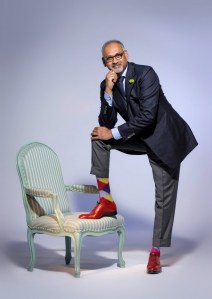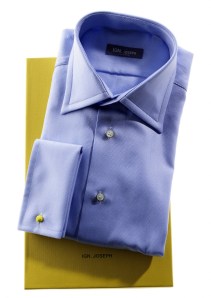A Chat About Shirts With Ignatious Joseph
 Ignatious Joseph is not a subtle man. I was on the telephone with him for nearly an hour – me in Washington, D.C., and he in Dusseldorf – and I barely got a word in edgewise. That was fine with me, because he knows how to tell a story, is passionate about his shirts and really knows from shoes.
Ignatious Joseph is not a subtle man. I was on the telephone with him for nearly an hour – me in Washington, D.C., and he in Dusseldorf – and I barely got a word in edgewise. That was fine with me, because he knows how to tell a story, is passionate about his shirts and really knows from shoes.
In fact, as we were speaking he asked if I had Scott “The Sartorialist” Schuman’s book. “Yes,” I replied, and dutifully fetched my copy that Scott was kind enough to sign for me when I interviewed him. Yep – there was Mr. Joseph, resplendent in a bowler hat, elegantly bundled scarf, tailored overcoat and those famous red shoes from his Viennese shoemaker.
The red shoes. “I like red shoes and have many pair, and after a while they became my calling card – it’s how people remember me. ‘Oh, you are the gentleman with the red shoes!'” He also like to wear his trousers on the short side and absolutely insists that Thom Browne copied him, and I don’t doubt him.

The Sartorialist’s shot
But what Ignatious Joseph is really know for are his shirts. Based on shirts from the 1930s, when the soft collar swept the menswear world, Mr. Joseph’s eponymous brand is coveted by bankers and traders from London to New York, Milan to Brussels. Shirts, and only shirts, are what Ignatius Joseph makes. And he makes some darn good shirts. I’ll be reviewing one myself in the near future, but I can say without reservation that his shirts are both noteworthy and noticeable. His signature soft collar and vibrant color schemes are the Ignatious Joseph calling card.

The philosophy behind the his shirts is simple: they are luxury shirts for everyday wear, or to put it another way, a modern sense of spirit derived from traditional craftsmanship. Ignatious Joseph shirts are what might be called semi-handmade and there is a reason for that.
Every worthy craftsman looks for ways to improve the quality and efficiency of his work methods; think of Jon Greene and his fantastic obsession with bespoke or Michael Drakes and his handmade ties. This shirt maker is no different; not necessarily rich, but absolutely passionate about his craft.

In order to guarantee both consistent quality and value for money, even the best shirt makers have chosen how and when to apply machines. The decision of what to do by hand and what to do by machine has to be taken with a view to the product as a whole, based on the skill and experience of the master shirt maker; it’s a blend of economics and craft.
Mr. Joseph’s shirts are made by shirt makers, primarily family businesses, who have refined and improved their craft over generations. “In order to produce shirts of the highest quality, and which are still affordable – meaning that there is a realistic margin for manufacturer and retailer – the critical tasks of cutting the shirts and sewing the non-fused collars are performed entirely by hand,” he says. Meanwhile the shirt’s torso is sewn by machine.


Non-fused collars are the trademark of the Ignatious Joseph shirt and it’s worth noting here that many high-end “handmade” shirts do not have hand sewn collars. This is mostly because of the expense and skill needed for such detailed work.
As far as he is concerned, every one of Ignatious Joseph’s shirt should be of the same high quality. This is only possible when each step of the shirt’s production is performed using the most appropriate method by experts in their craft. As he likes to say, “the whole product is made not only by hand but with brains.”
Sold in more than 80 stores around the world, 35 in the United States, Ignatius Joseph’s shirts may take a little effort to track down but, as he told me, “you won’t be walking ugly in the streets.”
Im so glad and ran into your blog. I love a great suit. I am sure going to try and track down some of these shirts..Im certainly a follower now.Mr. Goodwill Huntinghttp://g-w-hunting.blogspot.com